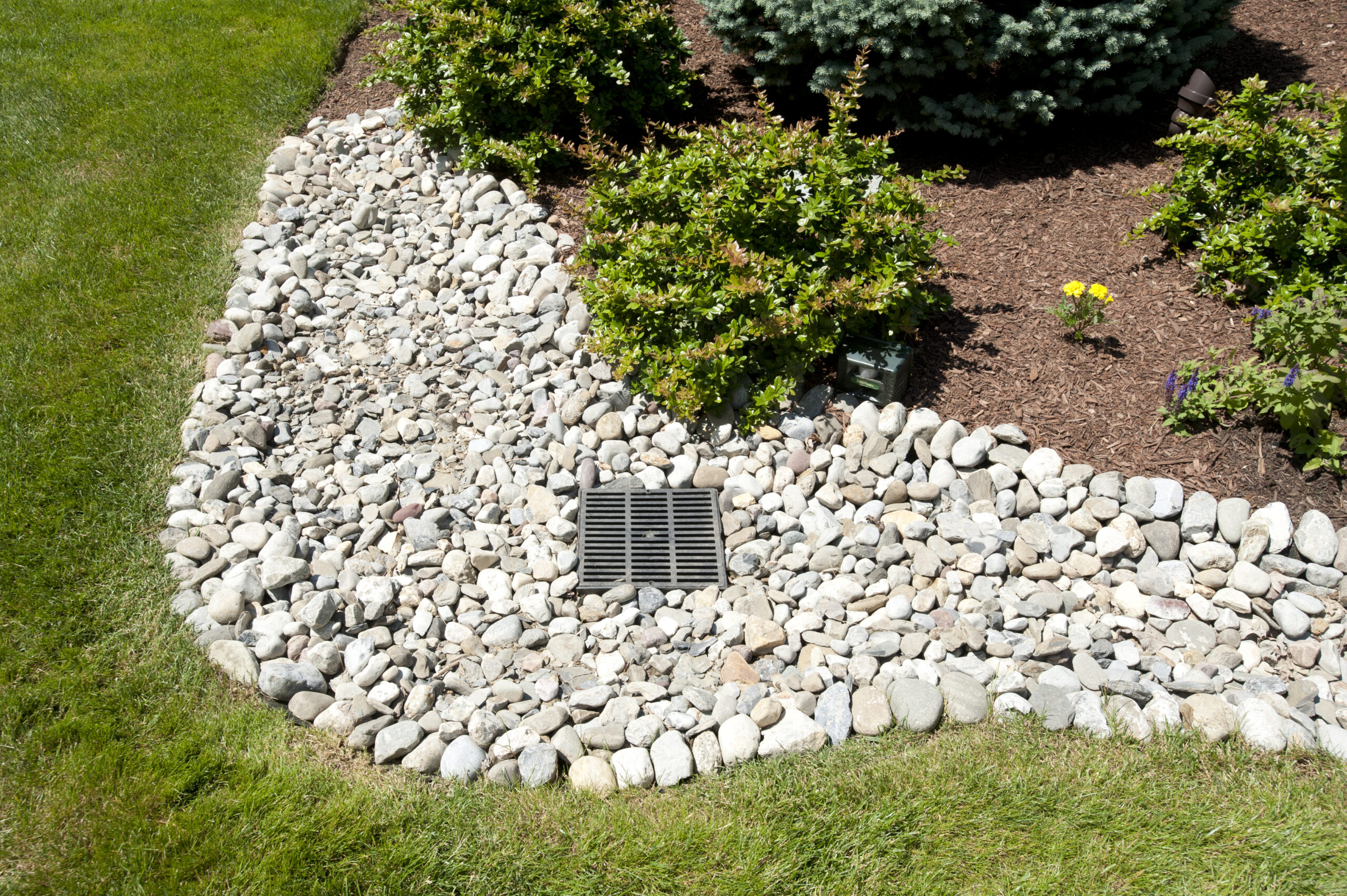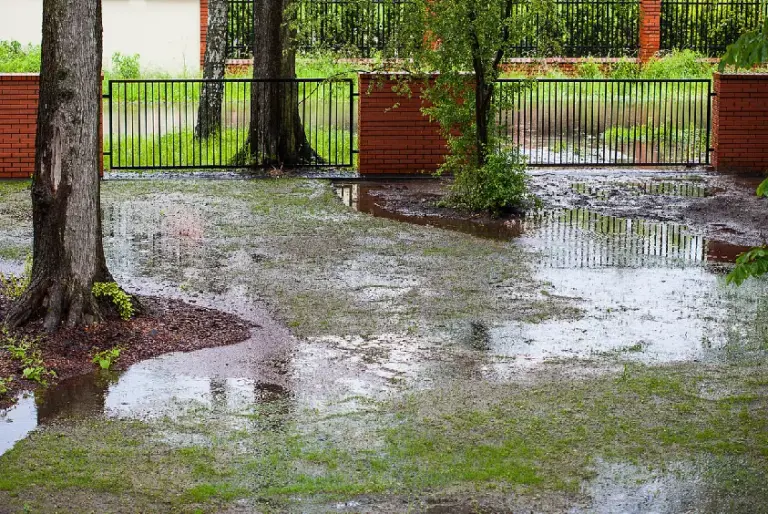Prevent Yard Flooding This Winter with Proper Drainage
Winter flooding can destroy your foundation and cost thousands in repairs, but most homeowners miss the critical warning signs until it’s too late. Here’s how frozen ground creates the perfect storm for disaster – and what smart homeowners do about it.
Key Takeaways
- Frozen ground prevents water absorption, creating flooding risks during winter thaws and snowmelt events
- Foundation damage from standing water can cost thousands compared to proactive drainage system installation
- Professional drainage solutions like French drains and sump pumps provide year-round protection when properly installed
- Pre-winter maintenance prevents ice dams and system failures that lead to basement flooding and property damage
- Warning signs include pooling water, foundation erosion, and basement moisture that signal immediate drainage issues
Winter weather creates the perfect storm for yard flooding disasters that catch homeowners off guard every year. When temperatures drop and precipitation increases, even well-maintained properties can experience devastating water damage that costs thousands to repair.
Why Winter Drainage Failures Cost Homeowners Thousands
Winter drainage failures create a domino effect of expensive problems that compound over time. Foundation repairs can range from $2,200 to $8,100 or more, while basement flooding restoration can average between $5,000 and $20,000, or higher depending on the extent of the damage. These emergency repairs far exceed the cost of preventive drainage installation, which typically ranges from $2,545 to $8,531, but can range from $800 to $15,000 or even $21,600 for complex projects, depending on system complexity and yard size.
The hidden costs accumulate quickly beyond the initial water damage. Mold remediation, damaged flooring, ruined personal belongings, and structural repairs create financial strain that proper drainage systems easily prevent. Sage Landscape Contractors has witnessed countless homeowners face these exact scenarios over their 40+ years serving New Jersey communities, where winter precipitation regularly tests drainage systems to their limits.
Insurance companies increasingly scrutinize flood claims, especially when drainage issues contribute to the damage. Many policies exclude coverage for preventable water intrusion, leaving homeowners responsible for the full repair costs when their drainage systems fail during winter weather events.
How Frozen Ground Creates Perfect Storm for Flooding
Water Can’t Penetrate Frozen Soil
Frozen ground acts like an impermeable barrier that prevents water absorption into the soil. When temperatures drop below freezing for extended periods, the ground hardens and blocks natural infiltration pathways. This forces all precipitation and snowmelt to remain on the surface, creating pooling and runoff that overwhelms drainage systems designed for normal soil absorption rates.
Rapidly Changing Temperatures Reduce Absorption
Temperature fluctuations during winter create inconsistent absorption conditions that compound drainage problems. Freeze-thaw cycles repeatedly expand and contract soil particles, reducing the ground’s natural permeability. Even when surface temperatures rise above freezing, deeper soil layers remain frozen for weeks, preventing effective drainage and forcing water to seek alternative pathways toward foundations and low-lying areas.
Snowmelt Overwhelms Systems Faster Than Rain
Snowmelt events deliver concentrated water volumes that exceed typical rainfall drainage capacity. A single inch of snow typically contains around 10% water content, but this can vary widely depending on the type of snow. Very light, dry powder can have as little as 3% water content, while heavy, wet snow can have 20% or more. Rapid melting during warm spells releases this water faster than frozen ground can absorb it. Multiple inches of accumulated snow can produce flood-level water volumes within hours, overwhelming gutters, downspouts, and yard drainage systems simultaneously.
Historical Flooding from Frozen Ground Runoff
Winter flooding events consistently demonstrate how frozen ground conditions amplify water damage risks. The combination of impermeable soil surfaces and concentrated precipitation creates runoff patterns that bypass existing drainage infrastructure. Properties that handle spring and summer rainfall without issues regularly experience basement flooding and foundation damage during winter months when frozen conditions prevent normal water absorption.
Warning Signs Your Drainage System Will Fail
1. Pooling Water Damages Turf and Creates Growth Problems
Standing water in winter kills grass roots and creates dead patches that require expensive lawn restoration. These soggy areas indicate insufficient drainage capacity that will worsen during heavy precipitation events. The water pools also freeze during cold snaps, creating ice hazards and further damaging underlying soil structure through repeated freeze-thaw cycles.
2. Foundation Erosion from Poor Grading and Downspouts
Improper yard grading directs water toward foundations instead of away from them, creating erosion patterns visible around the home’s perimeter. Downspouts that discharge too close to foundations compound this problem by concentrating water flow in vulnerable areas. These erosion signs predict basement flooding and foundation damage during winter weather when frozen ground prevents normal water dispersion.
3. Waterlogged Lawns from Compacted or Clay Soil
Compacted or clay-heavy soils retain water longer and freeze more completely than well-draining earth. Lawns that remain soggy days after precipitation indicate soil conditions that will create significant drainage problems during winter. These areas become completely impermeable when frozen, forcing all water to run off toward foundations and low points.
4. Basement Water Stains and Mildew Odors
Water stains on basement walls and musty odors signal existing moisture infiltration that will intensify during winter flooding events. These warning signs indicate that exterior drainage already fails to protect the foundation adequately. Without proper drainage improvements, winter precipitation will exploit these existing weaknesses and cause extensive basement flooding.
Winter Drainage Solutions That Work
French Drains with Proper Winter Insulation
French drains provide reliable subsurface water management that redirects groundwater away from problem areas and prevents basement flooding. These systems work below the frost line to maintain functionality during winter months. Proper installation includes gravel bedding, perforated pipes, and strategic placement that accounts for frozen ground conditions. French drains can freeze in extremely cold climates, but dry wells positioned at drain outlets provide backup protection.
Dry Wells Positioned Away from Foundations
Dry wells serve as underground collection tanks that slowly release water into surrounding soil, preventing surface flooding and recharging groundwater supplies. These systems excel in winter conditions because they store excess water until soil conditions allow proper absorption. Strategic positioning away from foundations ensures that collected water disperses safely without threatening structural integrity during freeze-thaw cycles.
Sump Pumps for Basement Protection
Sump pumps installed at property low points collect and remove excess water before it reaches basement levels. These systems provide active protection during winter flooding events when passive drainage alone cannot handle water volumes. Battery backup systems ensure continuous operation during power outages that commonly accompany severe winter weather events.
Pre-Winter Maintenance to Prevent Disasters
1. Clear Gutters to Prevent Ice Dams
Cleaning gutters and downspouts before winter prevents ice dams that cause water overflow and foundation damage. Debris blockages create ice buildup that forces water behind roofing materials and overwhelms drainage systems. Clear gutters ensure proper water flow away from foundations during winter precipitation events. Heat cables can be used in conjunction with PVC underground downspouts to help prevent ice blockage, but proper slope and overall drainage design remain the most important factors for system effectiveness.
2. Fix Yard Slopes That Direct Water Toward Home
Correcting improper yard grading before winter prevents water flow toward foundations during frozen ground conditions. Proper slopes direct surface water away from structures toward designated drainage areas. Winter maintenance includes checking these slopes for settling or erosion that compromises drainage effectiveness during critical weather periods.
3. Maintain Existing Drainage Systems
Regular cleaning of drains and sumps before winter ensures smooth water flow and prevents blockages in pipes. Debris removal from drainage paths maintains system capacity during high-volume water events. Professional inspection identifies potential failure points before winter weather tests system limits and reveals weaknesses through costly flooding incidents.
Foundation Damage from Freeze-Thaw Cycles
Standing water near foundations creates devastating damage through freeze-thaw expansion cycles that crack concrete and masonry. Water seeps into porous foundation materials and expands when frozen, creating structural damage that worsens with each temperature cycle. These cracks allow additional water infiltration during subsequent thaw periods, accelerating foundation deterioration and creating pathways for basement flooding.
Foundation damage from inadequate drainage compounds exponentially over multiple winter seasons. Small cracks become major structural issues requiring extensive repair work that disrupts daily life and strains household budgets. Professional waterproofing and drainage improvements prevent this progressive damage by eliminating standing water before freeze-thaw cycles can begin.
Professional Installation Costs vs. Foundation Repair Bills
Professional drainage system installation represents a fraction of foundation repair costs while providing decades of protection. Drainage solutions typically cost between $2,545 and $8,531, but can range from $800 to $15,000 or even $21,600 for complex projects, while foundation repairs from water damage can range from $2,200 to $8,100 or even $20,000 or more depending on the extent of the damage. The cost comparison becomes even more favorable when considering basement flooding restoration, mold remediation, and property damage that proper drainage prevents.
Professional installation ensures systems function correctly during critical winter conditions when DIY solutions commonly fail. Expert design accounts for soil conditions, climate factors, and property-specific drainage requirements that determine system effectiveness. The investment in professional drainage installation pays dividends through prevented damage costs and maintained property values over decades of reliable protection.
Protect Your Home Before Winter Weather Hits
Taking action before winter weather arrives prevents costly emergency repairs and protects property investments from predictable seasonal damage. Professional drainage assessment identifies vulnerable areas and designs solutions that handle winter conditions effectively. The relatively modest investment in proper drainage systems eliminates the stress and expense of dealing with flooding emergencies during severe weather events.
Homeowners who address drainage issues proactively avoid the disruption and expense that winter flooding creates for unprepared properties. Professional installation completed during favorable weather conditions ensures systems function properly when winter precipitation tests their capacity. This preparation transforms potential disaster scenarios into manageable weather events that well-designed drainage systems handle without incident.
Contact Sage Landscape Contractors at https://www.sagelandscaping.com/ to protect your property with expert drainage solutions designed for New Jersey’s challenging winter conditions.




